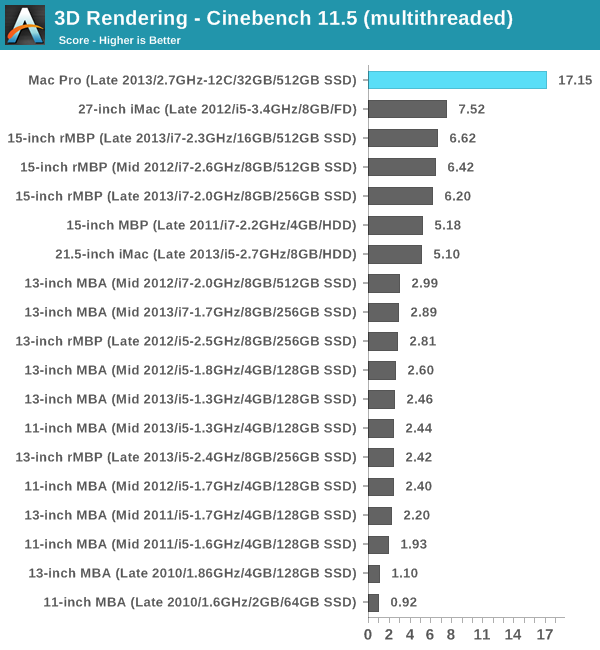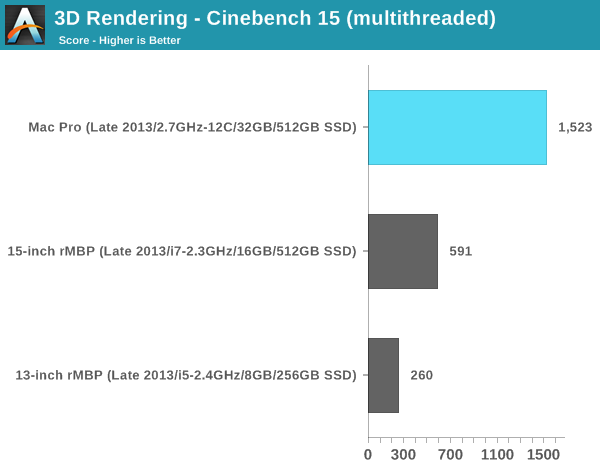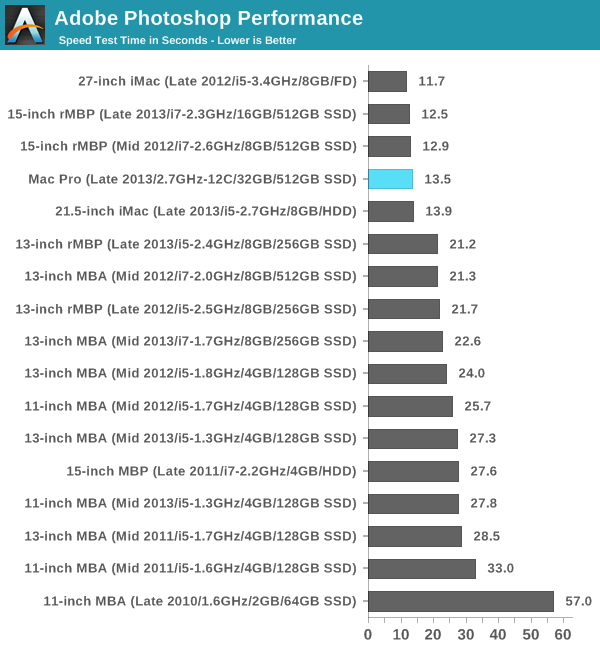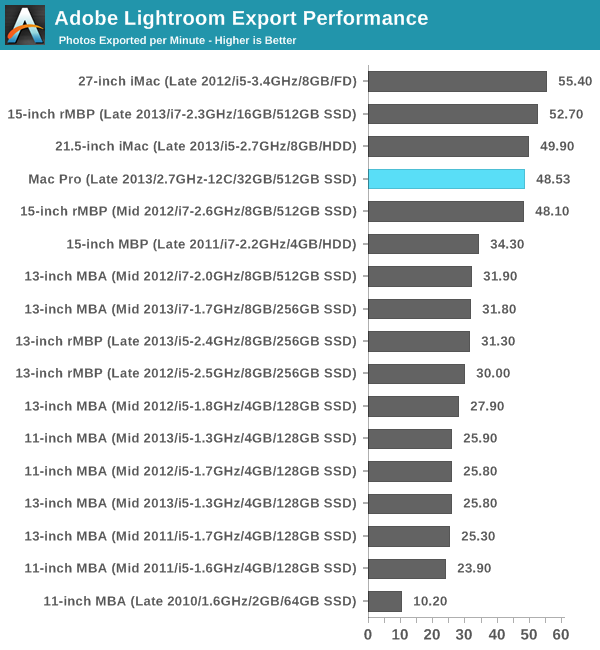The Mac Pro Review (Late 2013)
by Anand Lal Shimpi on December 31, 2013 3:18 PM ESTMac Pro vs. Consumer Macs
For my final set of CPU performance charts I put the new Mac Pro through the same set of tests I do all new Macs. There are definitely multithreaded components to these tests (some are indeed highly threaded), but the suite also values good single threaded performance. Here we'll get an idea of how the new Mac Pro, in its most expensive configuration, fares as a normal Mac.
I've already gone through Cinebench 11.5 results, but the following graphs should put in perspective the Mac Pro's performance relative to all consumer Macs:

If there's one graph that tells the story of why Intel's workstation roadmap is ridiculous, it's this one. The Mac Pro follows Intel's workstation roadmap, which ends up being cut down versions of Intel's server silicon, which happens to be a generation behind what you can get on the desktop. So while the latest iMac and MacBook Pro ship with Intel's latest Haswell cores, the Mac Pro uses what those machines had a year ago: Ivy Bridge. Granted everything else around the CPU cores is beefed up (there's more cache, many more PCIe lanes, etc...), but single threaded performance does suffer as a result.
Now part of this is exaggerated by the fact that I'm reviewing the 2.7GHz 12-core Mac Pro configuration. Single core turbo tops out at 3.5GHz vs. 3.9GHz for the rest of the parts. I suspect if you had one of the 8-core models you'd see peak single threaded performance similar to what the 2012 27-inch iMac delivers. The 2013 27-inch iMac with its fastest CPU should still be quicker though. We're not talking about huge margins of victory here, a matter of a handful of percent, but as a much more expensive machine it's frustrating to not see huge performance leadership in all areas.
The Mac Pro is designed to offer competitive single threaded performance, but really deliver for everyone who depends on great multithreaded performance:

If you need more cores, the Mac Pro is literally the only solution Apple offers that can deliver. We're talking about multiple times the performance offered by anything else in Apple's lineup with a Pro suffix.
I'm slowly but surely amassing Cinebench 15 results. The story doesn't really change here, I just thought I'd publish the numbers in case anyone wants data using this new test:


The latest versions of iPhoto and iMovie break comparisons to my older benchmarks so I've had to drop them here. I still have our Photoshop CS5 and Lightroom 3 tests though:

As I mentioned earlier, threading seems to have improved on newer versions of Photoshop. In CS5 our benchmark looks more like a lightly threaded test by comparison. Out of curiosity I ran the test under Photoshop CS6 and came away with a completion time of around 6 seconds.

Our Lightroom 3 export test tells a very similar story. Anyone with lighter workloads looking for a huge performance increase thanks to the Mac Pro will have to look elsewhere. The Mac Pro is at least performance competitive, but in these lightly threaded workloads you won't see a huge uplift.










267 Comments
View All Comments
JlHADJOE - Wednesday, January 1, 2014 - link
AFAIK the D700 is also a FirePro, and also has ECC on its VRAM.tipoo - Wednesday, January 1, 2014 - link
Wrong, it has no ECC. On OSX Apple writes much of the graphics driver anyways, so they can get away with calling Radeons FirePros as ECC isn't a necessity to call them that.Kevin G - Wednesday, January 1, 2014 - link
ECC on the FirePro's doesn't actually add additional RAM like it does on traditional server DIMM's. Instead as RAID5 like parity is performed on GPU memory channels to be able to be able to detect a memory error. Thus the 6 GB card will only have 5.25 GB available to use with ECC enabled. Since all the memory channel have to be used for a memory access, performance in some workloads takes a significant hit. I believe by default ECC is disabled for performance and memory capacity reasons.There is also one other difference between the D700 and the W9000: clock speeds and voltages. The D700 runs are a lower clock speed by default and presumably lower voltage to cut power consumption.
DaveGirard - Wednesday, January 1, 2014 - link
the D700 is clocked lower than the W9000. It's at 850MHz instead of 950.lilo777 - Wednesday, January 1, 2014 - link
Except it does not have ECC memory or the Pro drivers which are the only things that differentiate Pro from consumer grade cards. As such they are consumers grade cards (and the two year old generation) which cost around $700 at most not the $3500 pro cards.japtor - Wednesday, January 1, 2014 - link
There's never been a pro driver distinction in OS X, Radeons are validated for pro apps in OS X like FirePros in Windows. Granted there hasn't been the pro branding until now, but Apple does the drivers iirc so I don't see them bothering with splitting the driver base like AMD does.melgross - Wednesday, January 1, 2014 - link
You know nothing about Apple's drivers. I would bet that at the very least, they are based on the pro driver configurations, as apple has little interest in gaming, and a lot of interest in pro users. If you look at the performance of this in a pro app you can see that performance is pretty good. Mac Pro's are used in NASA, drug company research labs, CAD shops, video, photography labs and studios and publishing. Game drivers are of no interest to them.solipsism - Tuesday, December 31, 2013 - link
Note that he speculates that the CPU would be soldered (something no Mac Pro has ever had) and the thermal cap removed (something I believe Apple had only done once).Also note he doesn't have any more PCIe available for the SSD so he ends up going with the much slower SATA version but to make up some of the speed he gets 2x512GB in a RAID 0 configuration.
I like the case they used and I'm expect to see *more* of these smaller cases hit the market for DIYer and from OEMs now that Apple has stepped in.
Lonyo - Wednesday, January 1, 2014 - link
There are lots of small cases on the market and there have been for a while now... sure there could be more, but they are already widely available with a hell of a lot of variety of designs... not sure exactly how you think Apple will have any real impact on this market.If anything is going to have an impact it would be Steam boxes because OEMs might start pulling their fingers out and designing more gaming oriented small boxes, although they also are already rather common, but not always available for end users, such as the Alienware system which has a horizontal GPU mount with a riser.
solipsism - Wednesday, January 1, 2014 - link
Where are all these OEM PCs with very small cases but high performance like the new Mac Pro?